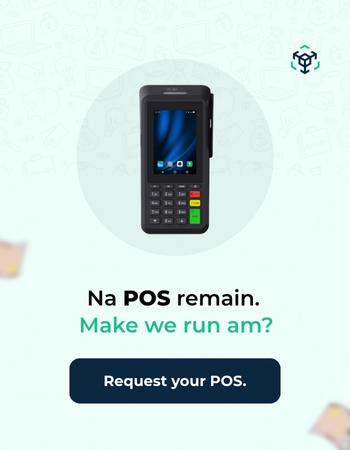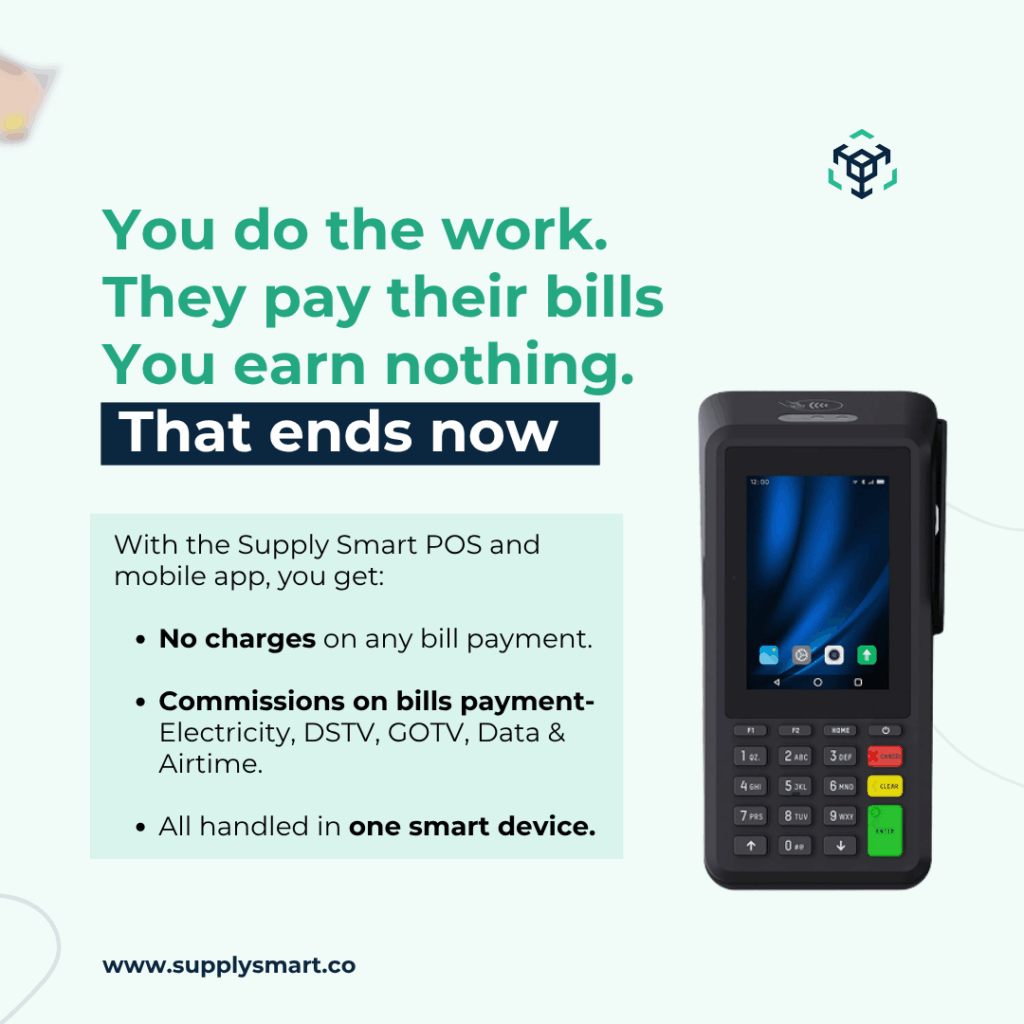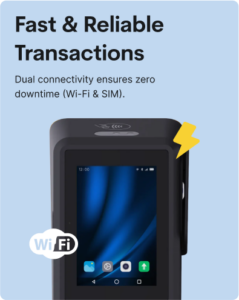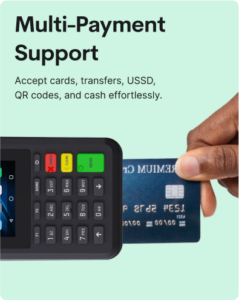You’ve probably heard that people are making “up to ₦5k to ₦15k daily” from their POS hustle.
But how much of that is actual profit? And how can you confidently calculate yours?
This guide is your no-fluff, beginner-friendly walkthrough to understanding profits in the POS business. We’ll break it down step by step, from revenue and expenses to the exact numbers you should track, plus mistakes to avoid.
First, Understand the POS Business Model
The POS (Point of Sale) business is part of Nigeria’s booming agency banking system.
It’s pretty simple: you use a POS terminal to help people withdraw, transfer, or deposit money, and in return, you earn a small commission per transaction.
Your Core Revenue Streams:
Service | How You Earn |
| Cash Withdrawals | Fixed fee per amount (₦50–₦100+ per withdrawal) |
| Transfers / Deposits | Commission per transaction |
| Airtime & Data Top-Ups | Commission (small, but adds up) |
| Bill Payments (TV, Electricity, Internet) | Commission or fixed markup |
Don’t sleep on the “small commissions.” Done right, they compound quickly.
In fact, many agents earn an extra ₦5k–₦20k monthly from value-added services like airtime recharge, bill payments, float transfer, and micro-insurance, even with low daily traffic.
What Affects Your Total Profit?
Before we calculate anything, you need to understand the forces at play:
1. Daily Transaction Volume
The more customers you serve, the more fees you collect. Simple math.
2. Commission & Charges
Some platforms (Moniepoint, Opay, PalmPay, etc.) give higher commissions than others. You need to know the different POS charges. Your profit depends on:
- What do you charge the customer
- What the aggregator/platform charges you
3. Location
High-footfall areas like markets, bus stops, or estate gates usually bring higher volumes.
4. Competition
If there are 10 POS agents in your area, your income will be spread thinner.
5. Service Reliability
Frequent network failures = lost customers = lost revenue (One major reason we designed Supplysmart POS with unlimited built-in data, so you never run out or lag.)
How to Calculate Your POS Profit (Step-by-Step)
Let’s get into the actual math. Here’s how to figure out what you’re truly making:
Step 1: Calculate Your Daily Revenue (Money In)
Let’s say you’re using a typical POS terminal that charges a 0.5% fee on cash withdrawals, capped at ₦100 for withdrawals of ₦20,000 and above. Here’s an example of a typical day’s transaction:
- 20 cash withdrawals at ₦100 profit per transaction = ₦2,000
- 10 transfers at ₦50 each = ₦500
- Airtime top-up profits = ₦200
Total Revenue = ₦2,700
Step 2: Subtract Daily Operating Cost (Money Out)
Now take out your regular daily expenses:
- Data = ₦200
- Power (charging your POS device) = ₦200
Total Daily Expenses = ₦400
Step 3: Net Profit
Revenue (₦2,700) – Expenses (₦400) = ₦2,300 profit for the day
Step 4: Monthly Profit
Multiply daily profit by working days in the month (e.g. 26 days):
- ₦2,300 x 26 = ₦59,800 per month
This is a realistic picture. Some days may be better, others slower.
Let’s look at how a more efficient POS system, like Supplysmart POS, can reduce costs and increase daily earnings:
Typical POS agents spend ₦150–₦300 daily just on data to keep their terminals running?
But Supplysmart POS comes with FREE unlimited data, built-in on a dedicated SIM. No recharge, no stress. Just turn it on and go.
Let’s recalculate with the Supplysmart terminal:
- Zero mobile data cost
- Less power usage (low battery drain)
- Expenses drop to ₦200/day
- New Net Daily Profit = ₦2,500
- Monthly Profit (26 working days) = ₦65,000
Extra ₦5,200/month saved, from just a smarter POS choice

Sample Scenarios: High vs Low Profit Areas
Ada, a POS Agent in Alaba Market (Bustling Market)
- 50 withdrawals daily at ₦100 = ₦5,000
- Other services = ₦1,000
- Expenses = ₦1,500
- Net profit = ₦4,500/day or ₦117,000/month
Tunde, a starter agent on a quiet street in Iyana Ipaja (Low-Traffic Street Corner)
- 10 withdrawals daily = ₦1,000
- Expenses = ₦800
- Net profit = ₦200/day or ₧5,200/month
Your location and hustle matter!
Hidden Costs That Eat Into Profit (Track These!)
People often make the mistake of focusing only on income, forgetting the many small costs that eat into their profit. Don’t be that person.
Startup Costs:
- POS Terminal Registration or Setup Fees
Running Costs:
- Float (working capital)
- Mobile Data (for internet-enabled terminals)
- Electricity (charging the device)
- Operator Commission (if someone else is manning your stand)
- Table, Umbrella or Kiosk Rent
- Security or daily fees (common in markets or bus stops)
Tools That Make Life Easier
1. POS Profit Calculator (Spreadsheet)
Track your income and expenses on one sheet. You can make use of Google Sheets for easier access
2. Mobile Apps
Use apps like “Money Manager” or even simple Excel on your phone.
3. Notebook & Pen (Old School but Effective)
Great for markets and low-tech areas.
Beyond Withdrawals: Hidden Income Streams Most Agents Ignore
Cash withdrawals will always be your bread and butter, but serious agents know the real money comes from diversification.
Don’t limit your POS to just one thing.
Here are revenue streams that can quietly boost your monthly profit:
Service | How It Pays |
| Bill payments (PHCN, DStv, Startimes, etc.) | ₦20–₦50 per transaction, often no effort required, just plug & pay |
| Airtime/Data Top-ups | ₦3–₦10 per transaction, but adds up in high volume |
| Float Sales to Smaller Agents | If you’re in a big area with smaller agents nearby, you can earn margins by offering float top-ups for a fee |
| Group Payments (e.g. Office staff subscription bundles) | Get 10+ people to pay bills at once = 10x commissions in one go |
| POS Rentals (if you own multiple devices, Supply Smart could be one of them.) | Rent spare devices to other trusted agents on low-traffic days |
| Micro-Insurance Activation (You need a Supply Smart POS for this) | Earn ₦100–₦300 per policy activated with no extra setup |
Most of these are low-effort, passive side income options that can add ₦5k–₦20k extra profit monthly with zero new costs.

Common Mistakes New Agents Make
- Ignoring small daily costs (they add up!)
- Overestimating customer demand in your area
- Choosing a poor location just because it’s cheap
- Not tracking performance daily or weekly
- Not going through the CBN guideline for the operation of POS
They’re a whole lot more, and I have a guide on more of these common POS mistakes and how to avoid them.
Frequently Asked Questions (FAQs)
Q: How much can I make from POS in Nigeria per day?
A: It depends on your location, foot traffic, and charges. It ranges from ₦1,000 to over ₦10,000 daily.
Q: Which POS gives the best commission?
A: This changes from time to time. As of now, Supplysmart, Moniepoint, and PalmPay are strong contenders.
Q: How can I increase my POS profit?
A: Offer more services (airtime, bills), operate in busy areas, reduce unnecessary expenses, and track your numbers.
Q: Can I start a POS business without experience?
A: Yes, but you need to learn fast. Start small, learn daily, and read my guide on how to start a POS business!
Q: How much capital do I need to start?
A: With ₦20,000 to ₦50,000, you can get a terminal, float, and basic setup.
Final Thoughts: Know Your Numbers, Grow Your Business
Calculating profits isn’t just about counting cash. It’s about understanding the health of your business. The POS business can be incredibly profitable, but only if you treat it like a business, not a gamble.
Track your revenue. Track your expenses. Check your location. And above all, be consistent.



